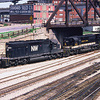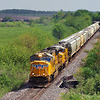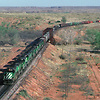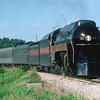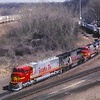| Matthias Rikka, Mătrescu Tudor, Felipe Martínez , Tudosă Mihai and 3 other liked this |
Wow !!! that is a massive power formation in lead .... any pushers ?
 No pushers here, but since this was during years when fuel was much cheaper, I sort of recall that all the units were working. It was not a long train, though - but it was a high-priority HPS (Houston-Portland-Seattle) run, and had some extra power added at Amarillo which needed to go up to Denver. Also, this was before distributed power was used a lot so, on this line, all power was placed at the head end of any train. Some of the extra units probably came down on loaded coal trains and would be removed when the trains were unloaded for the trip back north to the coal fields of Wyoming and Montana.
No pushers here, but since this was during years when fuel was much cheaper, I sort of recall that all the units were working. It was not a long train, though - but it was a high-priority HPS (Houston-Portland-Seattle) run, and had some extra power added at Amarillo which needed to go up to Denver. Also, this was before distributed power was used a lot so, on this line, all power was placed at the head end of any train. Some of the extra units probably came down on loaded coal trains and would be removed when the trains were unloaded for the trip back north to the coal fields of Wyoming and Montana.
Can you explain what "distributed power" means?
In the US and Canada, railroads have been trying to reduce crew size for many years, even while striving to increase train lengths. In steam days, every locomotive operated with its own crew and there was no way around it. With the electrical age it became possible to connect locos together with wiring, so multiple-unit diesels and electrics and longer trains could be operated by a single crew. Before radio remote control, pushers and mid-train helpers were still needed for long trains and each set of power still had to have a crew. Many experiments were done with various radio-controlled systems since the 70's, but fairly recently the practice of placing locomotives at both ends of a train has come to be known as "Distributed Power" or DPU. Early systems had problems with reception in tunnels or even in hilly territory, requiring the use of repeater towers on hill tops to relay signals from lead units to middle or rear-end power. These days the technology appears to be fully reliable and is used in the US and Canada on a daily basis. There are some trains here which frequently get some form of DPU; long 125-car coal, grain, double-stack container and crude oil trains are the most likely to have one or more units of distributed power. Sometimes even relatively short trains are set up with DPU.
That's interesting, thanks! Here in Estonia we don't use pushers on main lines, because Estonia is quite flat country:) We do have pushers on some industrial lines on rare occasions, but are then operated by separate crews.
Interesting! If I've understood correctly , this is called multiple working in the Uk.
Please log in to your account or sign up to like this picture or leave a comment





